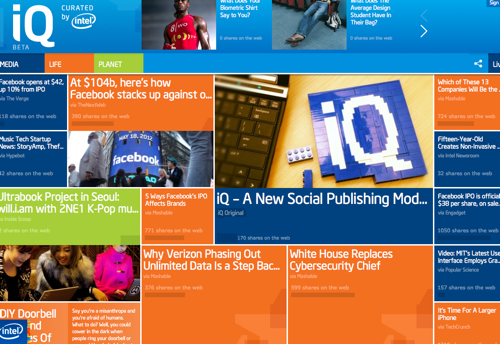Last week, Intel announced the launch of iQ, a website showcasing both original and curated content about how people are using technology in innovative ways. In iQ, Intel fuses publishing and social media into one impressive initiative, organizing content into three verticals: Life, Media, and Planet.
We recently spoke with managing editor Luke Kintigh about the editorial vision for iQ, turning Intel’s knowledge experts into content contributors, and the goal of keeping content focused on stories rather than products.
The Content Marketeer: What is the focus of iQ’s content?
Luke Kintigh: There is an overload of content on the web that details the “what”: what apps people subscribe to, what tech tools they use, etc. iQ’s goal is to steer away from producing a product-focused site to generating a storytelling site that introduces a more human aspect: the “how.” How is technology enabling humans to create amazing experiences on our modern planet?
In sharing content that showcases how humans are using technology, iQ has developed a fairly complex social algorithm that comes into play before visitors arrive at the site. Whether you’re reading articles from Mashable, Discovery News, Popular Science, The Next Web, or Ad Age, to name a few, these pieces of content have trickled through the algorithm and passed all tests to ensure they reflect the iQ vision. iQ’s content is refreshed every three to five minutes; turn your head and you might miss something.
TCM: What are the deciding factors and inspiration for iQ’s original content? How do you plan to make this content compelling?
Kintigh: No one can argue the talent inside Intel. Intel technology lives virtually everywhere; thus with an extensive list of experts, iQ can tell a very interesting story about technology. Outside of the beats the iQ core team creates, based on personal passion points mainly, there are various business units, locally and globally, producing original content for the site. Currently there is 35 to 40 percent of original content shared on iQ.
A significant part of this venture stems from employee engagement. Apart from iQ’s core team of nine, Intel has at least 5,000 storytellers. These 5,000 employees have been trained on social media. At launch, 160 of these social media practitioners [SMPs] were actively sending content to the site, becoming their own direct publishers. By equipping Intel employees with the tools and resources to be effective curators, Intel’s SMPs are the final human layer to the content surfacing. Thus, when you visit iQ, you know you are witnessing a knowledge-share of innovation and collaboration.
TCM: Do you have any fears about publishing on this scale?
Kintigh: My fear is that we gradually become more product focused, shoving content down people’s throats. This would associate Intel and iQ with the more traditional ways of marketing and advertising, where we would begin pushing content to audiences who really do not want that content. I hope we can continue to be good storytellers and that our content can bring to light the technological experiences in our modern planet.


